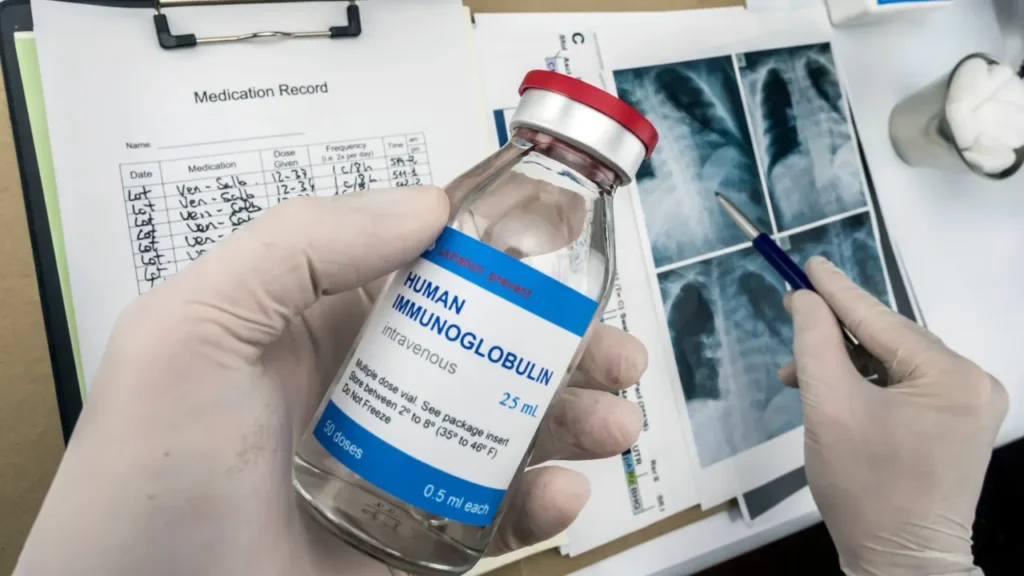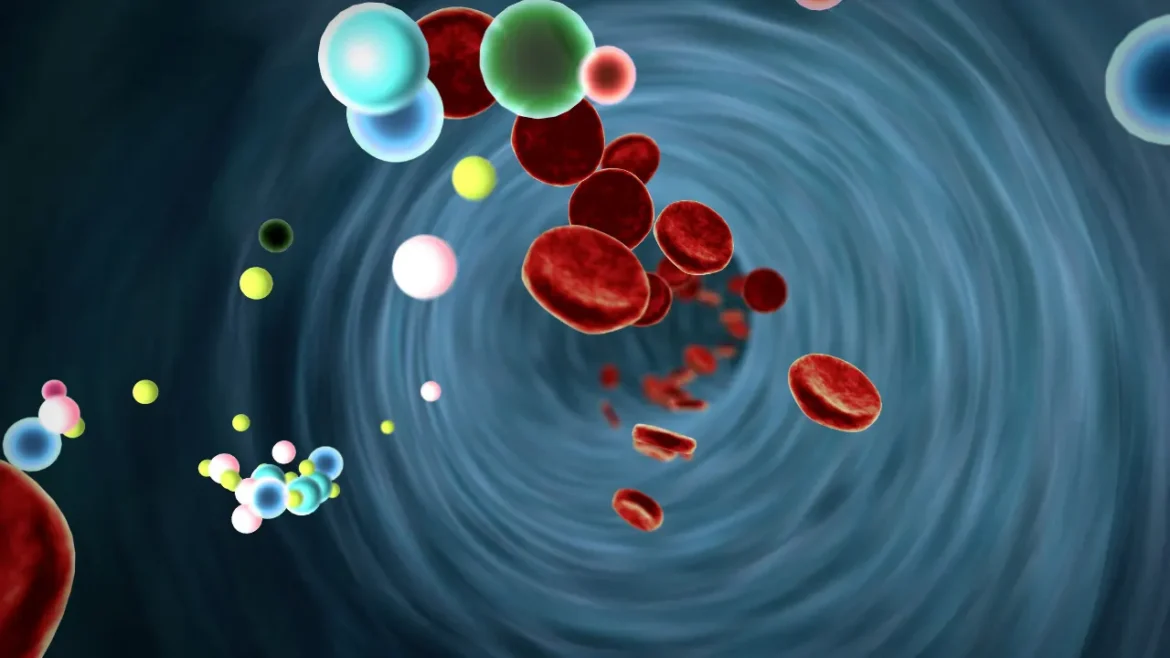Description
Agammaglobulinemia, primary is a rare hereditary condition marked by the lack or significantly reduced quantities of immunoglobulins, impairing immunological function. Agammaglobulinemia, primary, is also called Bruton Agammaglobulinemia or X-linked Agammaglobulinemia (XLA). It is marked by an absence or severe shortage of B cells together with immunoglobulins. This condition impairs the immune system and increases the risk of recurring infections.
Mutations within Bruton’s tyrosine kinase (BTK) genes, which affect B cell development, are frequently the cause of Agammaglobulinemia, primary. The development and persistence of B cells, which generate immunoglobulins, are critically dependent on BTK. Without a functioning BTK, B cells do not develop, which leaves them severely lacking in immunoglobulins, especially IgM, IgA, and IgG. As a consequence, people affected by/with this condition frequently get bacterial infections, mostly of the gastrointestinal and respiratory tracts.
You May Also Like:
TOP 3 MUSHROOMS FOR MEMORY– YOU WILL NEVER FORGET NUMBER ONE
THE CONNECTION BETWEEN MUSHROOMS AND COVID: 5 GREAT REASONS TO TRY FUNCTIONAL MUSHROOMS
Agammaglobulinemia, primary: Description, Causes, And Treatment Protocol is an original (HealthXWire) article.
Possible Causes
Agammaglobulinemia, primary is mostly brought on by genetic changes that interfere with the maturation and growth of B cells, resulting in an absence or lack of immunoglobulins. Mutations affecting the BTK genes in the X chromosomes are the most frequent genetic causes. This mainly, male-specific, disorder is referred to as X-linked Agammaglobulinemia (XLA).
The signalling pathways necessary for B cells to operate properly depend on the BTK genes. Antibodies, or immunoglobulins, produced by these cells are crucial for the immune system’s defense against infections. A significant deficiency or lack of immunoglobulins, in particular IgM, IgG, and IgA, occurs in people with primary Agammaglobulinemia when mutations within the BTK gene impair the normal growth and maturation of the B cells.
Although BTK gene mutations remain the most frequent cause of Agammaglobulinemia, primary, there are a few uncommon cases linked to abnormalities associated with different genes. For instance, in certain instances of Agammaglobulinemia, mutations within the heavy chain gene (IGHM) together with the -activating enhancer (E) area have also been reported.
Usually, X-linked recessive inheritance is used to pass on the genetic changes that cause Agammaglobulinemia, primary. Accordingly, males who receive a single mutant version of the BTK genes through their carrier mother may be affected. On the contrary, female people often inherit a single normal and a single mutant version of the gene, making them carriers of the disorder. Agammaglobulinemia can, on occasion, also occur in females who have two mutant variants of the BTK genes.
The existence of particular mutations that affect the BTK genes or other related genes is the main trigger of Agammaglobulinemia, primary, which should be emphasized as a genetic condition. It is not brought on by outside forces, lifestyle decisions, or exposure to the environment. Families with previous instances of Agammaglobulinemia, primary may benefit from genetic counseling or prenatal testing, especially to determine the likelihood of passing the disorder on to future generations and to make wise choices on family size
Exacerbating and Mitigating Factors
The management of people with Agammaglobulinemia, primary along with their outcomes, is influenced by aggravating and mitigating circumstances. The following are some elements that may impact how frequently and severely affected people get sick.
The following are some aggravating factors:
Inadequate Vaccination:
The risk of illness can increase if the proper vaccines are not administered by health care professionals and subsequently received. Immunizations are essential for preventing some bacterial and viral diseases, and people with Agammaglobulinemia, primary ought to adhere to suggested immunization schedules. Missed or incomplete vaccines can make people more vulnerable to some infections.
Suboptimal Infection Management:
Infections can aggravate the progression of the disease if they are treated slowly or ineffectively, which might cause problems. Early diagnosis, adequate diagnostic tests, and the beginning of antimicrobial treatment are essential for stopping infections in their tracks and lessening their effects.
Pathogen Exposure:
Individuals suffering from Agammaglobulinemia, primary are more susceptible to illnesses when exposed to microorganisms. Being around contagious individuals, congested areas, or healthcare facilities with high bacterial populations can all raise the chance of contracting an infection.
The following are some alleviating factors:
Proactive Infection Management:
For those with Agammaglobulinemia, primary preventative steps for controlling infections are essential. This entails keeping a regular eye on the symptoms, starting your antimicrobial therapy on schedule and taking antibiotic prophylaxis as directed. Preventive infection management reduces complications and enhances general health outcomes.
Prompt Diagnosis:
A timely start to therapy and preventative therapies is made possible by early and accurate detection of Agammaglobulinemia, primary. Early diagnosis enables the application of suitable management techniques to lessen the effects of immunodeficiency.
Initiation of Treatment:
In individuals suffering from Agammaglobulinemia, primary close surveillance of infections is crucial. Infections should be promptly identified and properly managed to reduce consequences. When necessary, medical personnel should attentively examine a patient’s symptoms, run the proper diagnostic procedures, and start early antimicrobial therapy.
Comprehensive Care:
The importance of having the opportunity to receive comprehensive care delivered by medical specialists skilled in treating immunodeficiency disorders cannot be overstated. Comprehensive care must include frequent follow-up appointments, immunoglobulin levels that are monitored, and immunization records that are evaluated.
Antimicrobial Prophylaxis:
People with Agammaglobulinemia, primary are frequently advised to take antibiotics as a preventative measure. Prophylactic antibiotics are frequently administered to patients to help prevent specific bacterial illnesses, especially those brought about by encapsulated bacteria. Maintaining protection against pathogens requires sticking to the recommended preventive regimens.

Standard Treatment Protocol
The conventional course of management of Agammaglobulinemia, primary mostly The conventional course of management of Agammaglobulinemia, primary mostly concentrates on treating immunodeficiency and avoiding reoccurring infections. The key aspects of the typical therapy protocol are:
Immunoglobulin Replacement Therapy (IRT):
Agammaglobulinemia, primary is treated primarily with immunoglobulin replacement therapy. To makeup for a lack of or not having endogenous immunoglobulins, exogenous immunoglobulins are given.
There are two main channels for administration, which are as follows:
- Subcutaneous Immunoglobulin (SCIG)
Subcutaneous injections are used to give SCIG either monthly or biweekly. Immunoglobulins are released more steadily, giving patients flexibility and convenience
- Intravenous Immunoglobulin (IVIG)
Every three to four weeks, IVIG injections are customary. Serum immunoglobulin levels are kept within the usual range by adjusting the dosage according to body weight.
IRT seeks to increase the general standard of life, decrease both the severity and frequency of illnesses and give passive immunity against numerous diseases.
Antibiotic Prophylaxis:
Individuals having Agammaglobulinemia, primary are frequently given antibiotic prophylaxis to prevent bacterial infections. Antibiotics that are frequently employed for this purpose are comprised of amoxicillin and penicillin, which have efficacy against encapsulated bacteria including Haemophilus influenzae and Streptococcus pneumoniae. According to patient-specific characteristics and local bacterial resistance patterns, the choice of antibiotics may change.
Infection Control and Monitoring:
In individuals suffering from Agammaglobulinemia, primary close surveillance of infections is crucial. Infections should be promptly identified and properly managed to reduce consequences. When necessary, medical personnel should attentively examine a patient’s symptoms, run the proper diagnostic procedures, and start early antimicrobial therapy.


Treatment Options
The therapy for Agammaglobulinemia, primary can be improved by adding a number of adjunct medicines to the conventional course of treatment. The effectiveness and safety of all these choices must be discussed with your medical professionals because they may differ depending on a variety of individual circumstances. The following are a few examples of adjunctive therapies:
Prescription Medications:
In some circumstances, prescription drugs other than antibiotics that are used for treating infections might be explored. Infections caused by viruses can be treated and prevented using antiviral drugs like valacyclovir or acyclovir, whereas fungal infections can be treated with antifungal drugs. Medical specialists should recommend the kind and length of treatment according to the kind and extent of the infection.
Over-the-Counter Formulations:
For mild illnesses like respiratory infections, over-the-counter medications may offer For mild illnesses like respiratory infections, over-the-counter medications may offer symptomatic relief. Decongestants, expectorants, and cough suppressants could all aid with symptoms. To avoid any potential interactions or negative side effects, it is imperative to speak with a healthcare provider before utilizing any over-the-counter remedies.
Nutritional Supplements:
Improving dietary status is crucial for sustaining overall immune function. Although nutritional supplements are unable to substitute immunoglobulin replacement treatment, they may provide supplemental assuagement of symptoms. Supplements with vitamins and minerals, like those with vitamin D, vitamin C, selenium, and zinc, may enhance immunological function. To guarantee safety and efficacy, dosages should be customized to each person’s requirements.
Natural and Herbal Remedies:
As complementary treatments for Agammaglobulinemia, primary, certain individuals may look towards natural and herbal medicines. It’s crucial that you remember that there is little scientific proof of their effectiveness. Astragalus, echinacea, and garlic are frequently referenced natural medicines that are thought to have immunomodulatory properties. Before taking natural or herbal medicines, it is imperative to speak with a healthcare expert because they may combine with certain prescriptions and cause varying personal reactions.
Although immunoglobulin replacement treatment along with antibiotic prophylaxis are the mainstays of the standard treatment procedure for Agammaglobulinemia, primary, supplementary therapies like prescription drugs, over-the-counter medications, dietary supplements, and homeopathic treatments may also be taken into account to improve disease management. To customize treatment programs according to individual needs, maximize results, and guarantee the safety and efficacy of adjunct medicines, patients and healthcare providers must work together in an integrated decision-making process.


Conclusion:
Agammaglobulinemia, primary is a perplexing condition with complex consequences. In some ways, while hereditary, the causes of the onset of this disease are unpredictable. Traditional medical protocol to treat this disorder is precise. While there are non-traditional aids for symptoms, at this time, research concludes the best treatment is with prescribed medications and procedures. Due to the severity of the disease and the effects of deviation from treatment, we advise great care for anyone with this condition or who is caring for someone with this condition. One way to help reduce the symptoms is to engage in lifestyle choices that support overall health, as those affects will aid in the subsidization of the condition in conjunction with prescribed treatment(s).


1. “Agammaglobulinemia.” Retrieved from: https://rarediseases.org/rare-diseases/Agammaglobulinemia/
2. “Agammaglobulinemia.” Retrieved from: https://www.ncbi.nlm.nih.gov/books/NBK555941/
3. “Agammaglobulinemia: X-Linked and Autosomal Recessive.” Retrieved from: https://primaryimmune.org/about-primary-immunodeficiencies/specific-disease-types/Agammaglobulinemia-x-linked-autosomal-recessive
4. “X-Linked Agammaglobulinemia.” Retrieved from: https://www.childrenshospital.org/conditions/x-linked-Agammaglobulinemia
Important Note: The information contained in this article is for general informational purposes only, and should not be construed as health or medical advice, nor is it intended to diagnose, prevent, treat, or cure any disease or health condition. Before embarking on any diet, fitness regimen, or program of nutritional supplementation, it is advisable to consult your healthcare professional in order to determine its safety and probable efficacy in terms of your individual state of health.
Regarding Nutritional Supplements Or Other Non-Prescription Health Products: If any nutritional supplements or other non-prescription health products are mentioned in the foregoing article, any claims or statements made about them have not been evaluated by the U.S. Food and Drug Administration, and such nutritional supplements or other health products are not intended to diagnose, treat, cure, or prevent any disease.
Table of Contents


